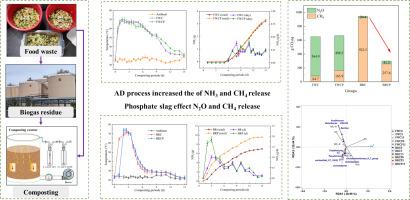揭示温室气体- nh3排放机制:食物垃圾堆肥和沼气渣堆肥的比较
Q1 Environmental Science
引用次数: 0
摘要
堆肥是食物垃圾和生物渣资源化利用的重要技术。然而,它面临着诸如温室气体(GHG)和气味排放等挑战。本研究比较了FW和BR堆肥的气体排放特性,并考察了磷渣的影响,旨在阐明排放机理,为优化堆肥实践提供指导。FW堆肥维持了7天以上的嗜热期(55°C),而BR堆肥受其有机质含量低的限制,未能维持类似的嗜热期。CH4是BR堆肥过程中排放的主要温室气体,占总温室气体(CO2-eq)的97.8%。磷酸渣改性有效降低了68.3%的CH4排放量。BR堆肥的CH4释放在前两天集中,主要受厌氧消化(AD)过程中残留的产甲烷菌和堆内厌氧条件的驱动。此外,由于AD过程中有机氮转化为NH4+, BR堆肥的NH3排放量(0.42 ~ 0.60 g/kg BR)显著高于FW堆肥(0.15 ~ 0.16 g/kg FW)。总体而言,在随后的BR堆肥过程中,AD增加了CH4和NH3的排放。相比之下,N2O是FW堆肥过程中排放的主要温室气体,占总温室气体排放(co2当量)的75.0% - 87.0%。较高的N2O排放发生在FW堆肥的早期阶段,与假单胞菌相对丰度超过25%相一致。这些发现突出了FW和BR堆肥的不同排放特征,并为制定针对不同有机废物流的有针对性的减排策略提供了基础。本文章由计算机程序翻译,如有差异,请以英文原文为准。

Revealing GHG-NH3 emission mechanisms: A comparison of food waste composting and biogas residue composting
Composting is a vital technology for the resource utilization of food waste (FW) and biogas residue (BR); however, it faces challenges such as greenhouse gas (GHG) and odor emissions. This study compares the gas emission characteristics of FW and BR composting and investigates the effect of phosphate slag, with the aim of elucidating the emission mechanisms and providing guidance for optimizing composting practices. FW composting maintained a thermophilic phase (>55 °C) for over 7 days, while BR composting, limited by its low organic matter content, failed to sustain a similar thermophilic phase. CH4 was the dominant GHG emitted during BR composting, accounting for 97.8 % of total GHG (CO2-eq). Phosphate slag amendment effectively reduced CH4 emissions by 68.3 %. CH4 release from BR composting was concentrated within the first two days, driven by residual methanogens from the anaerobic digestion (AD) process and anaerobic conditions within the pile. Additionally, BR composting emitted significantly more NH3 (0.42–0.60 g/kg BR) than FW composting (0.15–0.16 g/kg FW), due to the conversion of organic-N to NH4+ during AD process. Overall, AD increased CH4 and NH3 emissions during subsequent BR composting. In contrast, N2O was the primary GHG emitted during FW composting, contributing 75.0 %–87.0 % of total GHG emissions (CO2-eq). Higher N2O emissions occurred during the early stages of FW composting, coinciding with a Pseudomonas relative abundance exceeding 25 %. These findings highlight the distinct emission profiles of FW and BR composting and provide a basis for developing targeted emission reduction strategies tailored to different organic waste streams.
求助全文
通过发布文献求助,成功后即可免费获取论文全文。
去求助
来源期刊

Bioresource Technology Reports
Environmental Science-Environmental Engineering
CiteScore
7.20
自引率
0.00%
发文量
390
审稿时长
28 days
 求助内容:
求助内容: 应助结果提醒方式:
应助结果提醒方式:


